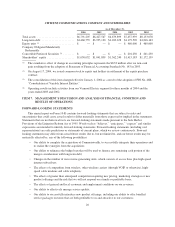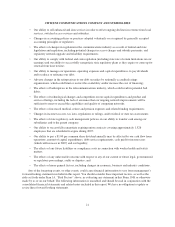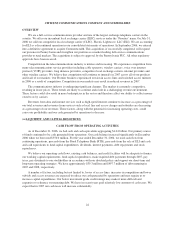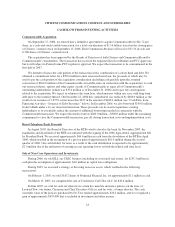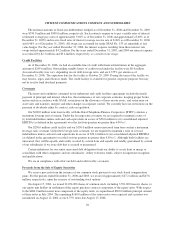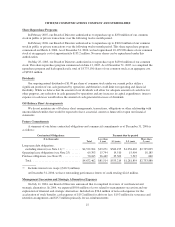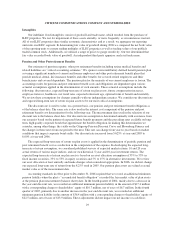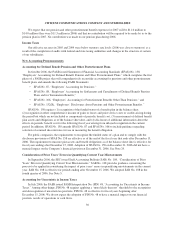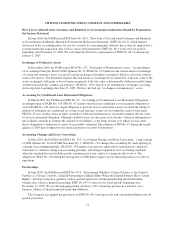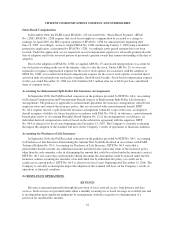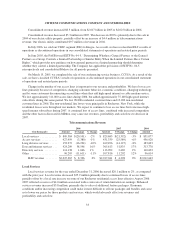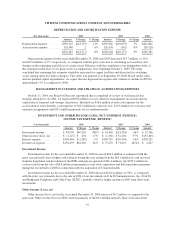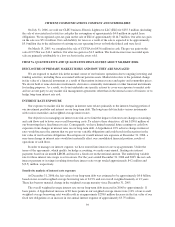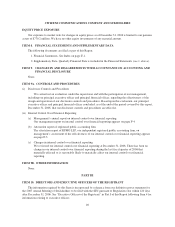Frontier Communications 2006 Annual Report Download - page 31
Download and view the complete annual report
Please find page 31 of the 2006 Frontier Communications annual report below. You can navigate through the pages in the report by either clicking on the pages listed below, or by using the keyword search tool below to find specific information within the annual report.
CITIZENS COMMUNICATIONS COMPANY AND SUBSIDIARIES
We expect that our pension and other postretirement benefit expenses for 2007 will be $11.0 million to
$14.0 million (they were $11.3 million in 2006) and that no contribution will be required to be made by us to the
pension plan in 2007. No contribution was made to our pension plan during 2006.
Income Taxes
Our effective tax rates in 2005 and 2004 were below statutory rate levels (2006 was close to statutory) as a
result of the completion of audits with federal and state taxing authorities and changes in the structure of certain
of our subsidiaries.
New Accounting Pronouncements
Accounting for Defined Benefit Pension and Other Postretirement Plans
In October 2006, the FASB issued Statement of Financial Accounting Standards (SFAS) No. 158,
“Employers’ Accounting for Defined Benefit Pension and Other Postretirement Plans,” which completes the first
phase of a FASB project that will comprehensively reconsider accounting for pensions and other postretirement
benefit plans and amends the following FASB Statements:
• SFAS No. 87, “Employers’ Accounting for Pensions;”
• SFAS No. 88, “Employers’ Accounting for Settlements and Curtailments of Defined Benefit Pension
Plans and for Termination Benefits;”
• SFAS No. 106, “Employers’ Accounting for Postretirement Benefits Other Than Pensions;” and
• SFAS No. 132(R), “Employers’ Disclosures about Pensions and Other Postretirement Benefits.”
SFAS No. 158 requires (1) recognition of the funded status of a benefit plan in the balance sheet,
(2) recognition in other comprehensive income of gains or losses and prior service costs or credits arising during
the period but which are not included as components of periodic benefit cost, (3) measurement of defined benefit
plan assets and obligations as of the balance sheet date, and (4) disclosure of additional information about the
effects on periodic benefit cost for the following fiscal year arising from delayed recognition in the current
period. In addition, SFAS No. 158 amends SFAS No. 87 and SFAS No. 106 to include guidance regarding
selection of assumed discount rates for use in measuring the benefit obligation.
For public companies, the requirements to recognize the funded status of a plan and to comply with the
disclosure provisions of SFAS No. 158 are effective as of the end of the fiscal year that ends after December 15,
2006. The requirement to measure plan assets and benefit obligations as of the balance sheet date is effective for
fiscal years ending after December 15, 2008. Adoption of SFAS No. 158 on December 31, 2006 did not have a
material impact on the Company’s financial position at December 31, 2006. See Note 24.
Consideration of Prior Years’ Errors in Quantifying Current Year Misstatements
In September 2006, the SEC issued Staff Accounting Bulletin (SAB) No. 108, “Consideration of Prior
Years’ Errors in Quantifying Current Year Misstatements.” SAB No. 108 provides guidance concerning the
process to be applied in considering the impact of prior years’ errors in quantifying misstatements in the current
year. SAB No. 108 is effective for periods ending after November 15, 2006. We adopted SAB No. 108 in the
fourth quarter of 2006. See Note 5.
Accounting for Uncertainty in Income Taxes
In July 2006, the FASB issued FASB Interpretation No. (FIN) 48, “Accounting for Uncertainty in Income
Taxes.” Among other things, FIN No. 48 requires applying a “more likely than not” threshold to the recognition
and derecognition of uncertain tax positions. FIN No. 48 is effective for fiscal years beginning after
December 15, 2006. We do not expect the adoption of FIN No. 48 to have a material impact on our financial
position, results of operations or cash flows.
30


